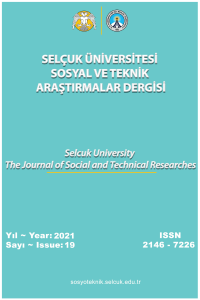Effect of Gamma Irradiation on Electrical and Photoelectrical Properties of CdFeTe Thin Films
Semimagnetic, Semiconductor, Thin film, γ-irradiation, VAX, Photoconductivity, XRD, SEM
Effect of Gamma Irradiation on Electrical and Photoelectrical Properties of CdFeTe Thin Films
Semimagnetic, Semiconductor, Thin film, γ-irradiation, VAX, Photoconductivity, XRD, SEM,
___
- [1] J. K. Furdyna, Diluted magnetic semiconductors: An interface of semiconductor physics and magnetism, Journal of Applied Physics - AIP Publishing, 1982, 53, 7637, doi.org/10.1063/1.330137
- [2] A. Mycielski, Fe‐based semimagnetic semiconductors, Journal of Applied Physics - AIP Publishing, 1988, 63, 3279, doi.org/10.1063/1.340813
- [3] A. Holda, A. Rodzik, A. A. Melnikov, P. Zhukowski. Allocation and Properties of Iron States in Cd1-xFexTe in Forbidden Gap Energy Range, Acta Phys.Polon., 1995, 87, 357, doi.10.12693/APhysPolA.87.357
- [4] P. Zhukovskii, Ya. Partyka, P. Vengerek, T. Koltunovich, Yu. Sidorenko, V. Stelmakh, N. Lapchuk. The alternating current conductivity and electron spin resonance Cd1−xFexTe compounds. Semiconductors, 2007, 41, 5, 544-548.
- [5] P. Zukowski, J. Partyka, P. We ˙ ¸gierek, J.W. Sidorenko, J. Szostak, A. Rodzik. Dielectric properties of Cd1−xFexTe semiconductor compounds. Semiconductors, 1999, 33, 3, 270-272.
- [6] S.A. Permogorov, T.P. Surkova, L.N. Tenishev. Exciton luminescence of Cd1−xFexTe solid solutions. Physics of the Solid State, 1998, 40, 5, 897-899
- [7] M. A.Mehrabova, N.H.Hasanov, N.I.Huseynov, A.I.Kazimova, Ab initio calculations of defects in Cd1-xMnxTe(Se) semimagnetic semiconductors, Journal of Radiation Researches, 2020, 7, 2, 39 – 42
- [8] Mehrabova M.A., Defect formation energy, impact of ionizing radiation on physical properties of II-IV groups’ chalcogenides. Journal of Radiation Research, 2017, 4, 1, 43 – 56
- [9] M.A.Mehrabova, H.R.Nuriyev, H.S.Orujov, A.M.Nazarov, R.M.Sadigov, V.N.Poladova. Defect formation energy for charge states and electrophysical properties of CdMnTe, Proc. SPIE Photonics, Devices and Systems VI, SPİE, 2015, 9450, 945001 – 9450010
- [10] M.A.Mehrabova, H.S.Orujov, N.H.Hasanov. Ab initio study of defects in CdMnTe: Electronic structure and related properties. International Journal of Materials Science and Applications, Science PG, 2014, 3, 6-1, 24 – 32
- [11] Mehrabova M.A., Nuriyev H.R., Orujov H.S., Hasanov N.H., Abdullayeva A.A., Suleymanov Z.I. Ab-initio calculations of electronic structure of CdFeTe and optical properties. Conference proceedings Modern Trends in Physics. Baku, 01-03 May 2019, 39-42
- [12] Mehrabova M.A., Nuriyev H.R., Orujov H.S., Hasanov N.H., Abdullayeva A.A., Nazarov A.M., Huseynov N.I., Gulmammadov K.D., Asadov F.G. First-principles study of defects in CdMn(Fe)Te. Effect of γ-irradiation on optical properties of CdMn(Fe)Te epitaxial films. 7th Rostocker International Conference “Thermophysical Properties to Technical Thermodynamics” (Thermam 2018), Almaniya, Rostok, 26th – 27th July 2018, 45
- [13] Мehrabova М.А., Nuriyev H.R., Оrujov H.S., Hasanov N.H., Кеrimova.Т.I., Аbdullayeva.А.А., Kazimova.A.I. Effect of gamma irradiation on conductivity of Cd1−xFexTe. Semiconductors, 2020, 61, 12, 2306-2309
- Başlangıç: 2011
- Yayıncı: Selçuk Üniversitesi
Geri Dönüştürülmüş Yapı Malzemelerinin Mimaride Kullanımının İncelenmesi
Aslı ÇÜÇEN, Yusuf Tahir ALTUNCI
İbadet ve Ruh Sağlığı İlişkisi Yönüyle İbadet Eğitimi
Antalya’da Yabancıların Gayrimenkul Edinimi Üzerine Ekonomik Bir Yaklaşım
Covid-19 Döneminde Dijital Pazarlama
Osmanlı’dan Cumhuriyet’e İdari ve Demografik Açıdan Şarlı
Regional Integration Theory and The Dilemma of Latin American Integration
Oween Cesar Barranzuela CARRASCO
Duyusal Alanda Salt Bilişsel Yordamalar ve Geleneksel Türk Ebru Sanatı
